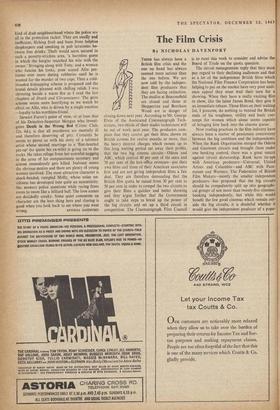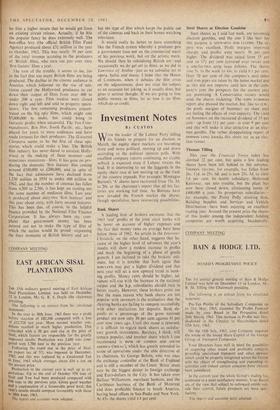The Film Crisis
By NICHOLAS DAVENPORT THEtua has always been a British film crisis and the one on hand has always seemed more serious than the one before. We are now told by the indepen- dent film producers. that they are facing extinction. The studios at Beaconsfield are closed and those at Shepperton and Boreham Wood are in danger of closing down next year. According to Mr. George Elvin of the Associated Cinematograph Tech- nicians, two-thirds of their studio technicians will be out of work next year. The producers com- plain that they cannot get their films shown on British screens for twelve months or more, that the heavy interest charges which mount up in this long waiting period eat away their profits, that the two big cinema circuits—Odeon and ABC, which control 40 per cent of the seats and 70 per cent of the box-office revenues—put their own films and those of their American associates first and are not giving independent films a fair deal. They are therefore demanding that the British film quota be raised from 30 per cent to 50 per cent in order to compel the two circuits to give their films a quicker and better showing and they argue further that the Government ought to take steps to break up the power of the big circuits and set up a third circuit in competition. The Cinematograph Film Council . is to meet this week to consider and advise the Board of Trade on the quota question.
The circuit managements reply that they must pay regard to their declining audiences and that as a lot of the independent British films which the National Film Finance Corporation has been helping to put on the market have very poor audi- ence appeal they must wait their turn for a showing. When they have a really exciting film to show, like the latest James Bond, they give it an immediate release. Those films on their waiting list, I presume, do nothing to remind the British male of his toughness, virility and basic con- tempt for women which alone seems capable of bringing him back into the cinema queue.
Now trading practices in the film industry have always been a matter of passionate controversy between the big combines and the independents. When the Rank Organisation merged the Odeon and Gaumont circuits and brought them under one booking control, there was a great outcry against circuit dictatorship. Rank have tie-ups with American producers—Universal, United Artists and Columbia—and ABC with Para- mount and Warners. The Federation of British Film Makers—mostly the smaller independent producers—has proposed that the big circuits should be compulsorily split up into geographi- cal groups of not more than twenty-five cinemas, booking independently, but while this would benefit the few good cinemas which remain out- side the big circuits, it is doubtful whether it would give the independent producer of a popu- lar film a higher return that he would get from an existing circuit release. Actually, if he hits the popular fancy he does extremely well. The box-office levy (the official British Film Fund Agency) produced about £3 million in the year to October, 1962. This was nearly 50 per cent of the total revenue accruing to the producers of 'British' films, who turn out just over sixty 'first feature' films a year.
The root of the trouble, it seems to me, lies in the.fact that too many British films are being produced. The decline in the cinema audience in America which followed on the rise of tele- vision caused the Hollywood producers to cut down their output of films from over 400 to under 200 a year. Film studios were closed down right and left and sold to property specu- lators. The few remaining producers concen- trated on the big epic films, which might cost $5,000,000 to make, but could bring in fantastic profits when successful. The Ten Com- mandments, Ben liar, South Pacific, etc., have played for years to mass audiences and have made fortunes for their producers. The ill-starred Cleopatra seems to be the first of these epic stories which could make a loss. The British film industry has never dared to emulate Holly- wood in the making of these monster--and sometimes monstrous—films. It has gone on pro- ducing the domestic 'first feature' film costing around £100,000 to £200,000, and in spite of the fact that admissions have declined from 1,250 million in 1954 to under 400 million in 1962, and that the number of cinemas has fallen from 4,509 to 2,566, it has kept on turning out the same number of mediocre films. Last year it produced about sixty-two 'first features' and this year about sixty, with forty second features. This has been due, of course, to the helpful finance provided by the National Film Finance Corporation. It has always been my com- plaint that - government money has been Poured out not to make the type of film of which the nation would be proud--expressing the liner moments of British history and art-- but the type of film which keeps the public out of the cinemas and back in their homes watching television.
It would really be better to have something like the French system whereby a producer gets a government loan not on the commercial merit of his previous work, but on the artistic merit. We should then be subsidising British art:--and occasionally we do get art in films, as we did in Lawrence of Arabia—just as we subsidise art in opera, ballet and music. I hope that the House of Commons, when it debates the film crisis on the adjournment, does not treat the subject as an occasion for joking, as it usually does, but gives it serious thought. If we are going to lose public money in films, let us lose it on films which do us credit.































 Previous page
Previous page